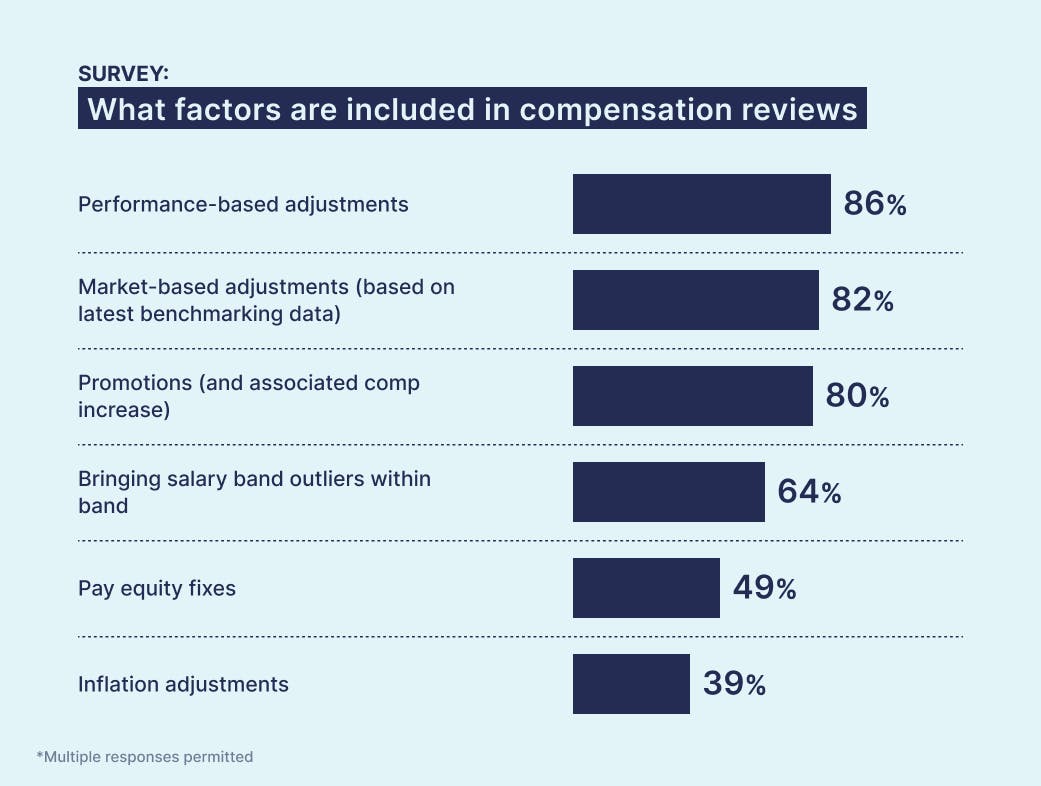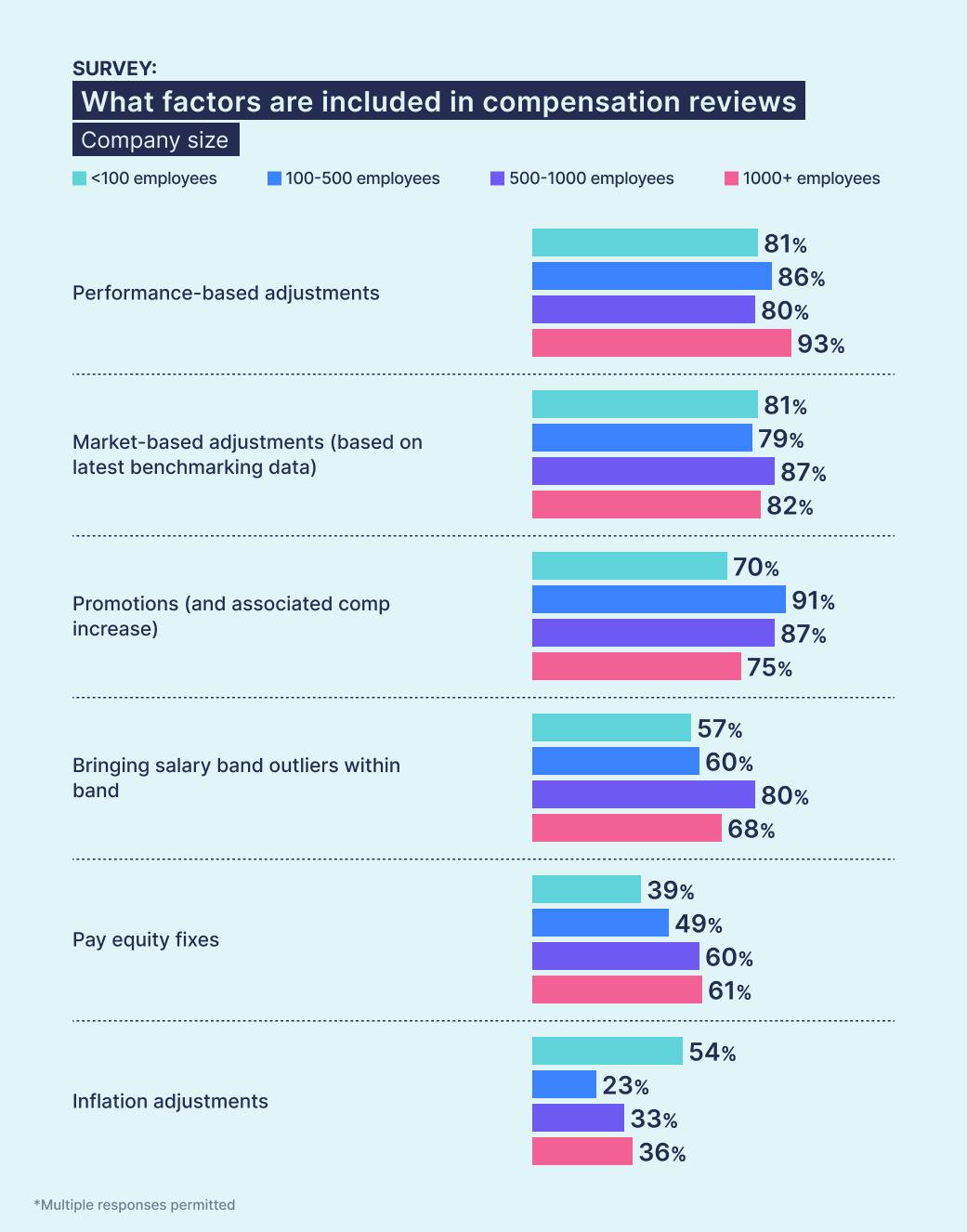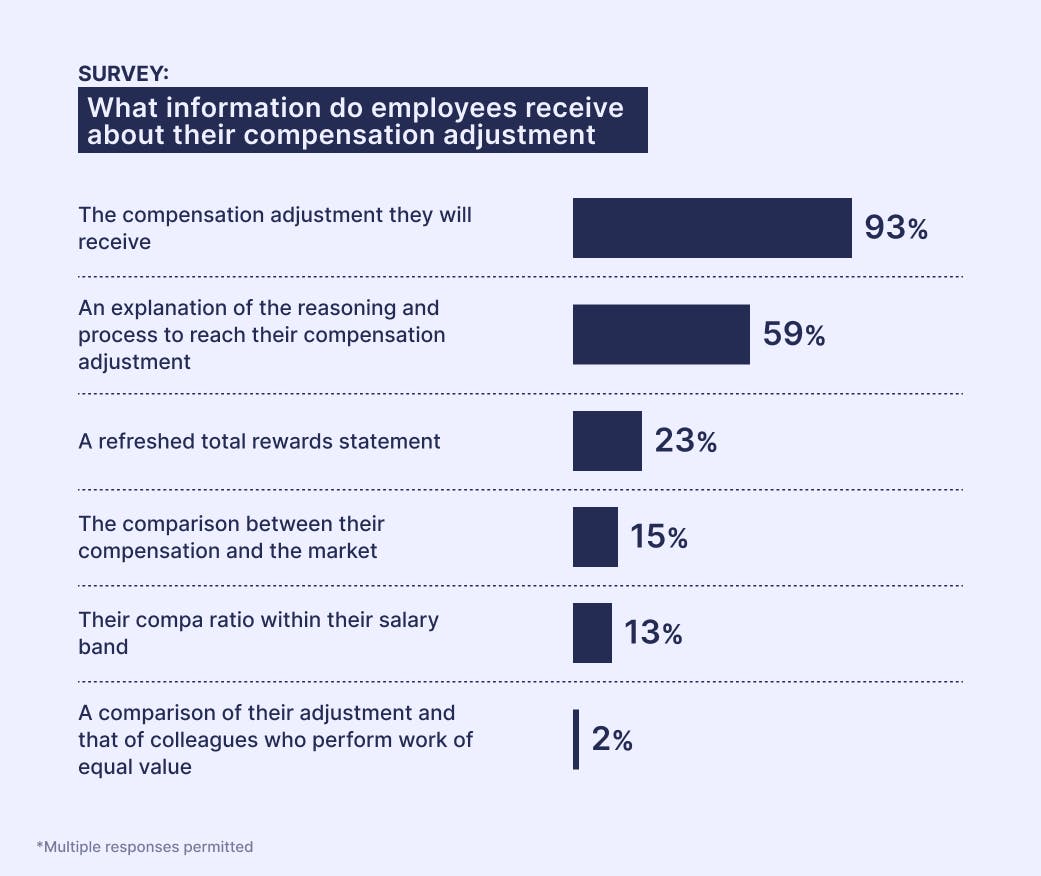"We'll just run a pay equity audit when the regulations hit, and fix any issues then."
Heightening regulations are forcing companies to make pay equity a priority. But most companies are focusing on treating the symptoms, not the cause.
In our recent survey of 140 companies we found that pay equity is currently disconnected from compensation review decisions. While 86% adjust salaries for performance during reviews, only 49% use the process to address pay equity issues.
Pay gaps don't happen overnight. They compound through hundreds of compensation decisions – the high performer who gets 10% instead of 5% because he's more vocal about his achievements, the new hire brought in above band because they negotiated better.
The solution isn't one-off fixes, or setting up a standalone pay equity project group when the EU Pay Transparency Directive forces your hand.
To truly address pay equity, it needs to be part of your compensation DNA – embedded in the philosophy, built into every process, informing every decision, and included as a key factor in every single compensation review cycle.
Let’s take a look at the survey insights – and then we’ll learn how the pay equity experts (Monica Öberg, Vicky Peakman, and Jenny Packer) are doing it.
Subscribe to our newsletter for monthly insights from Ravio's compensation dataset and network of Rewards experts 📩
The data: pay equity currently takes a backseat in compensation review decisions
Salary reviews are a big moment in the compensation calendar for employers and employees alike. It typically includes rewarding employee performance and ensuring their pay remains market competitive – which makes it a perfect time to also be analysing and addressing pay equity issues.
But 51% of tech companies do not currently include pay equity as a decision-making factor when adjusting salaries during their compensation reviews (Ravio survey, August 2025).
This gap is even more pronounced in smaller companies – just 39% of companies with fewer than 100 employees including pay equity fixes in their reviews, compared to 61% of companies with over 1,000 employees.
Jenny Packer, Senior Reward Consultant at Gallagher (currently gathering insights on workplace trends), points out this company size variance is likely compliance-driven.
“The higher number we see with larger employees may be driven by legislation requirements (depending on their location),” she says, “but addressing pay equity should be a priority regardless of headcount – waiting until you're forced by regulations will only create compounding problems that become much harder to fix."
Another challenge emerges when we look at how salary adjustment decisions are made.
80% of companies give managers some level of discretion on salary adjustments (with variance on how exactly this is done) – in recognition of their close knowledge of team performance.
However, our survey finds that:
- 35% of companies have no final HR team approval or override mechanism on salary adjustments decided by line managers
- 42% of companies do not require managers to document the justification for the adjustment they decide on
- 45% of companies have no pay equity check before finalising the salary adjustments.
Every subjective decision made without clear rationale can easily contribute to inequity – so where line managers have input on the salary adjustment, we should see checks and balances in place to ensure consistent and equitable decisions are being made.
Jenny highlights that this is particularly true where rewarding performance plays a role – which we’ve already seen is a very popular factor in salary adjustments.
“Performance focus can damage pay equity projects too,” she highlights. “If top performers repeatedly get a base salary increase (and maybe they were hired at a higher base) then it quickly causes compounding inconsistencies."
Even more telling is what companies communicate about review outcomes.
While 93% tell employees their individual salary adjustment, only 59% explain the rationale behind it. And just 2% share how their adjustment compares to colleagues who perform work of equal value – communicating the pay equity implications of the review to the team.
This communication piece matters, because the EU Pay Transparency Directive will soon require companies to explain their pay structures to employees, as well as giving employees the right to request information about peers doing equal work.
Companies avoiding these conversations now will find themselves scrambling to build transparency into their culture later – and with compensation reviews such a staple in the Rewards calendar already, this should be a natural time to do that.
How to embed pay equity into your compensation review process (expert advice)
The data paints a clear picture: while most companies diligently adjust for performance, pay equity is often getting pushed to the margins in compensation review processes – which could leave many companies with unknown issues that will only compound over time.
To understand how to shift from reactive gap-fixing to proactive prevention, we spoke with three pay equity experts:
- Jenny Packer, Senior Reward Consultant at Gallagher
- Vicky Peakman, Director at Fair Pay Partners
- Monica Öberg, Fractional HR Leader & Pay Equity Consultant
Their message is unanimous: stop treating pay equity as a separate compliance project.
Instead, make it as fundamental to your compensation processes as market benchmarking or performance ratings. Here's how they recommend making that shift.

Tip 1: Build equity into your foundations, not just your review cycle
"In most companies pay equity is handled by legal or compliance,” explains Vicky Peakman, “I think that’s the major reason that pay equity isn’t included in every pay review, because it isn’t thought of as part of Rewards.”
“In reality, every reward decision is a potential pay equity issue,” Vicky says.
Pay equity can't be treated as an annual exercise or compliance checkbox – it needs to be woven into the very fabric of how compensation decisions are made.
For Jenny Packer, it’s the “early leadership commitment” that’s so essential, so that “driving pay equity is treated as a core value of the organisation.”
So the foundation must start with compensation philosophy, ensuring stakeholder buy-in on pay equity as a core principle of how compensation decisions are made.
And Jenny’s seen this work firsthand. "We worked with a medium not-for-profit organisation who developed comprehensive policies on pay equity,” she recalls. “By having strong leadership buy-in, and then instilling change from the leadership team down, they were able to influence and modify how line managers across the organisation approached pay."
Once the philosophical commitment exists, pay equity needs to be built into your compensation structures and processes.
For Monica Öberg, “job levelling is the most natural place to start."
"Well-defined levels give you an anchor for salary offers and promotions,” Monica explains, “
which removes a lot of bias and back-room negotiating that can lead to inequity."

Those structured levels (with clear descriptions of the scope of each level, tied to objective criteria) then inform level-by-level salary bands – and the conversation shifts from "What do we think they’ll accept?" to "Where in that band should this person sit?"
When pay equity is a principle in your compensation philosophy and embedded in your foundational structures, it becomes as natural a part of your compensation reviews as checking for market competitiveness.
Tip 2: Address pay equity fixes before other adjustments in your compensation review process
With pay equity built into your compensation foundations, it’s easier to ensure it stays front of mind during compensation reviews – but it’s still important to intentionally embed it into the process.
Vicky’s advice is to make pay equity the first factor that’s addressed in the review. “Pay equity fixes should go in first, so that any performance or market increases are on top of those,” she explains.
This sequencing matters because (as Jenny highlighted earlier) performance increases can worsen pay gaps. If someone is already overpaid due to strong negotiation skills and then receives a large performance increase, while their underpaid peer gets the same percentage, the absolute gap between them grows even wider.
By addressing pay equity gaps first, you create a clean baseline to make informed decisions on market or performance adjustments too.
Tip 3: Use salary band position to guide merit increases
Even after fixing existing pay equity issues, you need to ensure that new performance adjustments don't create new inequities.
Jenny Packer’s recommendation is to use salary band position as a factor when calculating merit increases.
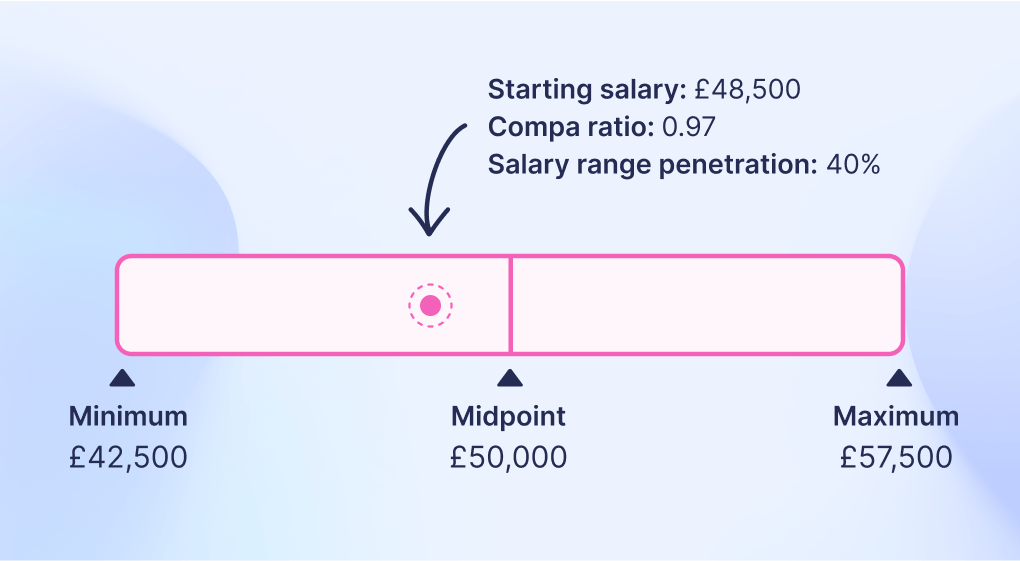
“We often suggest considering market position and performance in tandem," she explains, "so that your top performers who are also sitting lowest in their range get a larger slice of the budget to bring them to a more equitable position.”
This approach – often implemented through a merit matrix – avoids all high performers receiving the same percentage increase, which can compound existing pay equity issues.
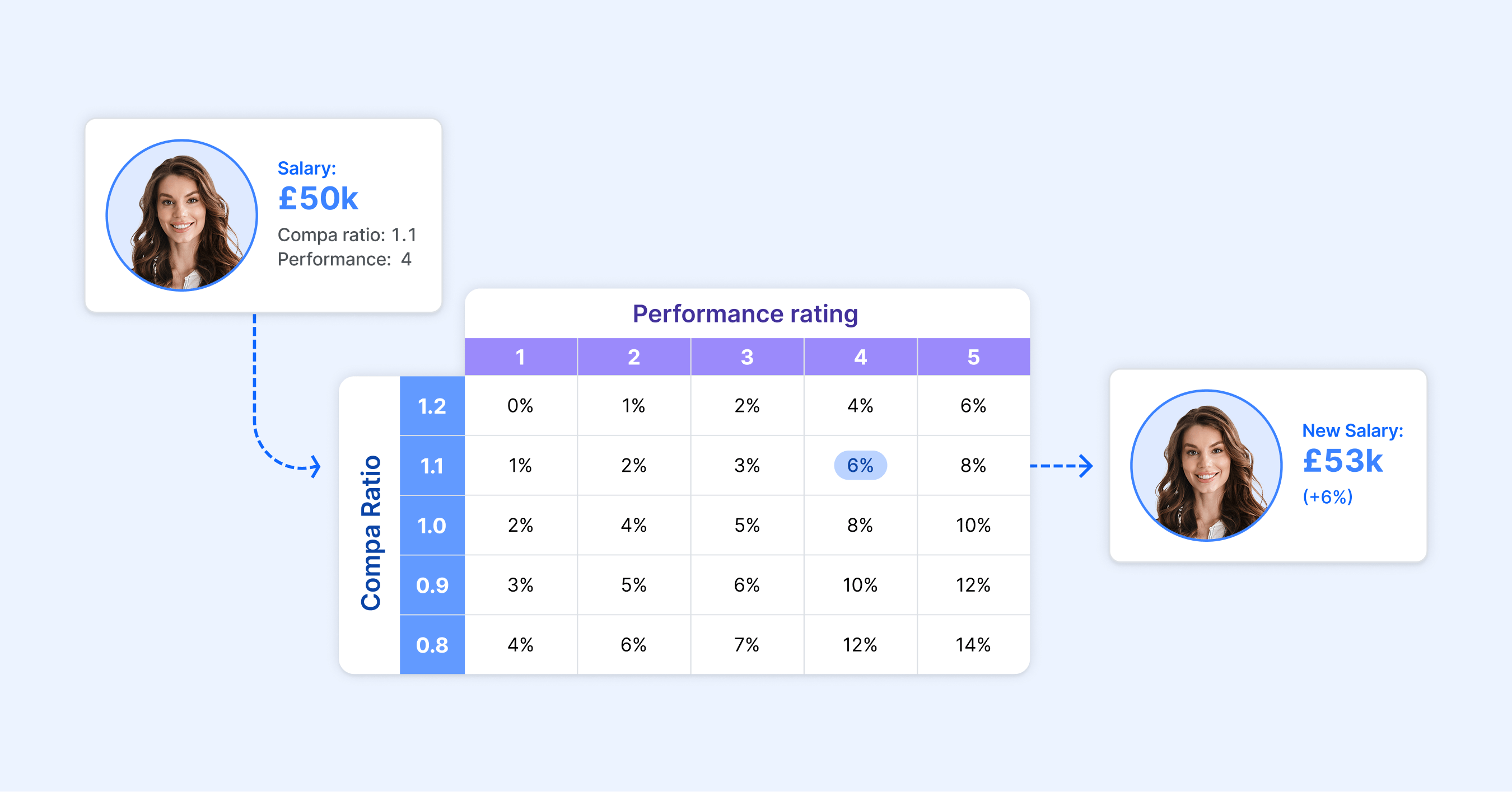
“It does also mean that high performers who are already top-of-band may not get any base salary increase at all,” notes Jenny. “This is important for pay equity, but you’ll need to consider how to use other compensation levers to reward performance, like spot bonuses or additional holiday days.”
Tip 4: Create structured guardrails for manager input on compensation adjustments
Earlier we saw that 80% of companies give line managers some level of discretion over salary adjustments. And that makes sense, because managers have the closest view of individual work, performance, and potential.
But, without proper guardrails, this discretion can undermine pay equity efforts.
“Manager discretion is often code for bias, favouritism, or just inconsistent decision-making,” says Monica Öberg.
Monica instead advocates for giving managers "informed choice” with clear guardrails.
“To get manager input, the trick is to give informed choice and never free-for-all discretion,” she explains. “Give them a recommended adjustment for each direct report, based on objective data, and with a narrow range for them to choose within. Then review those recommendations through calibration sessions. That way, managers feel ownership over the decisions, but the system is still protecting pay equity.”
Vicky Peakman has a similar view. “It’s really hard for managers to be impartial when thinking about pay increases for their team,” she says.
“So I’d always suggest that a recommended adjustment comes from the People team first, based on all the inputs you’ve gathered. Then allow managers to put forward any changes to that recommendation, but with guidance on what justification they need to provide for it to be approved by their own manager, and by HR.”
This justification element is particularly important in the light of the incoming EU Pay Transparency Directive, which will require companies to justify any pay differences between employees doing equal work. Having documented rationales isn’t just good practice, it’s becoming essential for compliance too.
Tip 5: Build in bias checks at multiple stages of the compensation review
Even with structured guardrails in place, bias can still creep into compensation decisions, so it’s also crucial to have checks built in throughout the review process (not just at the end).
Are there any bias-related patterns in performance ratings?
"Performance ratings should always be analysed to ensure that there is no bias," recommends Vicky. "Is one group receiving unexpectedly high performance ratings? If so, further checks need to be done to ensure that isn’t coming from subjectivity.”
If bias does seem to be a factor, it’s then also important to reflect on the performance review process and try to eliminate that bias.
“To mitigate subjectivity you need to make performance evaluations as standardised as possible,” says Vicky. “Think of it in a similar way to standardised job interviews and assessments – decide the questions you want to ask and ask those same questions to everyone."
“Defined distributions for performance ratings can also be useful to check the spread of performance is as expected, and check for outliers. But don’t force distributions, especially with small teams, as that can be unfair.”
Have we calibrated all manager input and reviews?
Calibration (or moderation) sessions are where manager decisions get reviewed collectively to ensure consistency across teams.
As Monica explains, this is where you "review those recommendations at calibration" to ensure managers are applying guidelines consistently and fairly, and that all feedback is captured.
During calibration, you're looking for patterns: Is one manager consistently rating some team members higher than others without objective reasoning? Is another manager avoiding giving top ratings even when warranted? Are managers in certain departments interpreting performance criteria differently?
Jenny emphasises the importance of "central oversight" during the review process to ensure "there's no deviation from established guidelines." This collective calibration step is vital to catch any deviations that do exist, before they can turn into inequities.
The goal isn't to force uniformity but to ensure fairness. When managers know their decisions will be reviewed alongside their peers' decisions, it encourages more thoughtful, objective assessments from the start.
Have we checked how final adjustments will impact pay equity?
"Once the final decisions are made, a final pay equity check should be done,” recommends Vicky, “especially if you have a lot of management or leadership discretion in the final figures.”
This final pay equity check is important to reflect on the final decisions made on compensation adjustments, analysing whether the process has been fair and grounded in pay equity as a core principle, as well as how the final adjustments will impact pay equity across the entire company.
For Jenny, conducting a pay equity audit as part of the compensation review process gives you an opportunity to “identify and address any disparities that might have arisen through the process quickly, and before the decisions are rolled out to employees."
By building these checks throughout the process, you catch problems while they can still be fixed.
Tip 6: Train managers to own the pay equity conversation
Once pay equity is an important factor in your compensation review process, it’s crucial that this is communicated effectively to your employee base.
“We’ve seen in Ravio’s research that 68% of managers aren’t well-prepared for compensation conversations,” points out Monica, “and that’s the overall figure – I’d expect it to be even higher if we focused on pay equity conversations specifically.”
And Vicky adds to this that “The EU Pay Transparency Directive will also give employees new rights to information about pay structures and average salaries, so it’s now a compliance need for companies to train managers to be able to articulate how the company ensures it is paying fairly – and compensation reviews are a natural time that questions will arise from employees.”
So how do we prepare line managers better?
Monica’s advice is: “don’t make them improvise.”
Provide line managers with training on pay equity, and how it’s factored into compensation decisions at the company, as well as the frameworks and example scripts they need to bring that into their 1:1 conversations.
"It's amazing how much a manager just saying 'we benchmarked against the market, here's where you stand, and here's what it takes to move up' provides clarity for employees,” Monica explains, “corporate silence means employees fill in the gaps for themselves on how decisions are made.”
Jenny has seen success when companies embed compensation conversations into regular manager-employee conversations.
"We’ve worked with several companies to improve how compensation is communicated, and the 1:1 conversations are normally the key to better outcomes,” she shares.
“When managers are having open discussions, referencing the company’s compensation philosophy, and embedding a culture of inclusiveness and transparency around pay, the team feels supported. Individuals are empowered to discuss their pay, gain clarity on how to advance it, and even challenge how individual decisions are made – it hugely increases employee engagement.”
In summary: Making pay equity business-as-usual in your compensation review process
Our data revealed a troubling disconnect: while 86% of companies adjust for performance during compensation reviews, only 49% address pay equity in the same process.
But as our experts have shown, the review cycle is the perfect place to embed pay equity checks – you're already making compensation decisions, so why not ensure they're equitable ones?
The path forward is clear. Start by building equity into your compensation foundations, then weave it through every stage of your review.
As Monica put it: "You don't just show up and run a marathon – you map out your plan from meals to workouts so it's part of your everyday routine."
The same principle applies here. When pay equity is embedded in your compensation philosophy, frameworks, and processes, maintaining fair pay stops being a huge project to tackle, and starts being business-as-usual.

